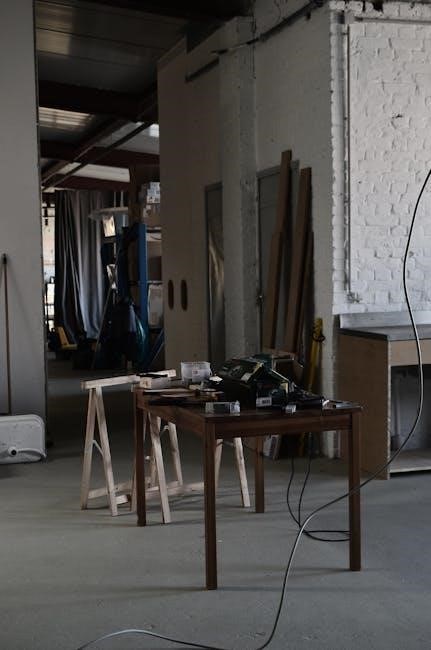Loft Bed Assembly: A Comprehensive Guide
Embark on your loft bed assembly journey with confidence! This guide provides comprehensive instructions, safety precautions, and troubleshooting tips, ensuring a smooth and successful setup for your new space-saving bed.
Assembling a loft bed might seem daunting, but with the right approach, it can be a manageable and rewarding task. Loft beds are excellent space-saving solutions, particularly in dorm rooms or smaller living areas. This guide serves as your comprehensive resource, providing clear, step-by-step instructions to ensure a safe and successful assembly.
Before you begin, it’s crucial to gather all the necessary tools and carefully inventory all parts. Familiarize yourself with the components and hardware. Safety should be your top priority, so always follow the provided precautions. Whether you’re dealing with a wooden college loft bed or a metal frame, the fundamental principles of assembly remain consistent. This guide covers various loft bed types, including those with desks, bookshelves, or ladders. By following these instructions carefully, you’ll transform your space with a functional and stylish loft bed. Remember to consult the manufacturer’s instructions for your specific model, as variations may exist.

Preparing for Assembly
Before diving into the assembly process, proper preparation is key. This involves inventorying parts, gathering tools, and understanding essential safety precautions to ensure a smooth and safe construction experience.
Inventory of Parts and Hardware
Prior to commencing the loft bed assembly, a meticulous inventory of all parts and hardware is absolutely essential. Begin by carefully unpacking all components and comparing them against the parts list included in the assembly instructions, often available as a PDF document.
Ensure you have all the necessary bed frame pieces, including side rails, headboard, footboard, and any support beams. Verify the presence of all required hardware, such as screws, bolts, washers, and connecting brackets. Pay close attention to the quantities of each item to avoid delays during assembly.
If any parts are missing or damaged, immediately contact the manufacturer or retailer for replacements. Do not proceed with the assembly until all components are accounted for and in good condition. This proactive step will save you time and frustration, guaranteeing a seamless and structurally sound loft bed assembly. Carefully review the instructions provided.
Tools Required for Assembly
Before embarking on the loft bed assembly process, gathering the necessary tools is paramount for a smooth and efficient experience. While specific requirements may vary depending on the loft bed model, some essential tools are universally recommended.
A power screwdriver with a Phillips head is highly recommended to save time and effort when securing screws; A manual screwdriver set is also useful for tighter spaces or more delicate connections. A rubber mallet can help gently align and join parts without causing damage.
A measuring tape is indispensable for ensuring accurate alignment and spacing. A level is crucial to guarantee the bed frame is perfectly horizontal and stable. Consider having a wrench or adjustable pliers on hand for tightening bolts. Safety glasses are also essential to protect your eyes from debris. Having these tools readily available will streamline the assembly and ensure a secure, well-constructed loft bed.
Safety Precautions During Assembly
Prioritizing safety during loft bed assembly is paramount to prevent injuries and ensure a secure final product. Always read and understand the assembly instructions thoroughly before commencing any work. It is strongly recommended to have at least two people involved in the assembly process, especially when lifting or maneuvering heavier components.
Wear safety glasses to protect your eyes from potential debris or splinters. Ensure the assembly area is clear of obstructions and well-lit. When using power tools, exercise caution and follow manufacturer’s guidelines. Avoid over-tightening screws or bolts, as this can damage the components. Double-check all connections and ensure they are securely fastened.
Be mindful of pinch points and avoid placing hands or fingers in areas where parts could suddenly shift or collapse. If you encounter any difficulties or uncertainties during assembly, consult the instructions or seek professional assistance. By adhering to these safety precautions, you can minimize the risk of accidents and ensure a safe, successful loft bed assembly.

Step-by-Step Assembly Instructions
Follow these detailed steps to assemble your loft bed safely and efficiently. Each step is designed for clarity, ensuring a sturdy and reliable final product.
Assembling the Bed Frame
Initiate the assembly by carefully laying out all the bed frame components, ensuring the “good” side of the wood faces upwards to achieve a more aesthetically pleasing finish. Using the provided hardware, connect the bed ends (A) to the side rails (B). Secure these connections with bolts, washers, and nuts, tightening them just enough to hold the frame together loosely.
Next, attach the stretcher bars (G) to the frame, which provide essential support for the mattress platform. Ensure correct alignment before fully tightening the bolts. Now, position the top platform panels (H) on top of the stretcher bars, securing them with screws.
Double-check that all connections are snug but not overtightened at this stage. This allows for minor adjustments later. Once the frame is fully assembled, proceed to tighten all bolts and screws securely, ensuring a stable and robust bed frame.
Attaching the Ladder and Guardrails
With the bed frame assembled, the next critical step is attaching the ladder and guardrails, essential for safety and accessibility. Begin by positioning the ladder at the desired location, typically on the shorter side of the loft bed frame. Secure the ladder to the frame using bolts, washers, and nuts, ensuring it’s firmly attached and can bear weight safely.
Next, install the guardrails along the open sides of the upper bunk. Attach the guardrails to the bed frame using the provided hardware, ensuring they are securely fastened and provide adequate protection against falls. Pay close attention to the placement and spacing of the guardrails, as specified in the instructions, to maximize safety.
Double-check that both the ladder and guardrails are stable and properly aligned before proceeding. Tighten all connections securely to prevent any movement or instability during use.
Securing the Loft Structure
Once the main components are assembled, securing the entire loft structure is paramount for stability and safety. Begin by carefully inspecting all connections and joints throughout the frame. Ensure that every bolt, screw, and fastener is tightened to the manufacturer’s specified torque.
If the loft bed includes any locking mechanisms or safety pins, engage them according to the instructions. These features provide an extra layer of security, preventing accidental disconnections or collapses. Consider using wall anchors or brackets to further stabilize the loft bed, especially if it’s placed on uneven flooring or in a high-traffic area.
Attaching the loft bed to the wall can significantly enhance its stability and prevent it from tipping over. After securing all connections, gently test the loft bed by applying pressure to different points of the frame.

Post-Assembly Checks
After assembling your loft bed, perform thorough checks. Ensuring stability and safety is paramount. Tighten connections and double-check all parts for a secure and worry-free loft bed experience.
Ensuring Stability and Safety
Post-assembly, verifying the loft bed’s stability and safety is crucial. Begin by gently shaking the entire structure to identify any wobbling or instability. Pay close attention to the joints and connections, ensuring they are firmly in place. Any movement indicates a potential weakness that requires immediate attention. Double-check that all screws, bolts, and other fasteners are tightened securely, but avoid over-tightening, which could damage the wood or strip the threads.
Inspect the ladder for secure attachment and stability, ensuring it can support weight without shifting. Confirm that the guardrails are properly installed and provide adequate protection against falls. If the loft bed includes a desk or other features, test their weight capacity and stability. Consider adding non-slip pads to the ladder steps and the bed’s feet to enhance safety and prevent movement on smooth floors. Regularly inspect the bed for wear and tear.
Tightening All Connections
After the initial assembly of your loft bed, a meticulous check and tightening of all connections are paramount for ensuring its long-term stability and safety. Begin by systematically inspecting each bolt, screw, and fastener used throughout the assembly process. Use the appropriate tools, such as a screwdriver or wrench, to gently but firmly tighten each connection. Avoid applying excessive force, as this can strip the threads or damage the surrounding wood.
Pay particular attention to the connections between the bed frame, ladder, and guardrails, as these are critical for structural integrity. If you encounter any loose or wobbly connections, re-tighten them immediately. For connections that seem particularly stubborn, consider using a lubricant like wax or soap to ease the tightening process. Re-check all connections regularly.

Troubleshooting Common Issues
Encountered a snag? Don’t worry! This section addresses common loft bed assembly challenges, offering practical solutions for missing parts, alignment difficulties, and other potential setbacks to ensure your bed is safely assembled.
Missing Parts or Damaged Components
Discovering missing or damaged components is a common frustration during loft bed assembly. Immediately halt the assembly process if you encounter such issues. Refer to your parts inventory list to confirm exactly what is missing or damaged. Do not substitute parts with alternatives, as this could compromise the bed’s structural integrity and safety.
Contact the manufacturer or retailer immediately. Most companies have dedicated customer service lines for addressing these concerns. Provide them with the model number of your loft bed, the specific part number (if available), and a clear description of the issue. Digital photos of any damage can expedite the process.
While awaiting replacement parts, carefully store the partially assembled bed in a safe location. Keep all hardware organized to prevent further loss. Avoid using the bed until all missing or damaged components are replaced and the assembly is completed according to the instructions.
Many manufacturers offer online resources or downloadable assembly instructions. Double-check these resources for clarification on parts identification. In some cases, what appears to be a missing part may simply be a component that is packaged within another item.
Difficulty Aligning Parts
Encountering difficulty aligning parts is a common hurdle during loft bed assembly. Before forcing any connections, carefully re-examine the assembly instructions. Ensure you are using the correct parts for each step and that they are oriented properly. Misalignment often stems from incorrect initial connections.
Loosen any previously tightened bolts or screws to allow for greater flexibility. This can provide the necessary wiggle room to align components correctly. If the instructions recommend a specific sequence for tightening hardware, adhere to it closely. Tightening some connections prematurely can restrict movement and hinder subsequent alignment.
Consider using a rubber mallet to gently tap parts into place. Avoid excessive force, which could damage the components. If significant resistance persists, double-check the parts’ orientation and the assembly steps. Enlist a second person for assistance. Additional hands can provide the leverage and support needed to align stubborn pieces.
If alignment issues persist, consult the manufacturer’s website or customer support for troubleshooting tips specific to your loft bed model. Online forums and video tutorials can also offer valuable insights and solutions.